How effective are
immunizations?
Immunizations
are largely a 20th-century development. Since coming into widespread use, immunizations have saved
billions of lives around the world. They have enhanced the quality of life, eliminated a
huge burden of suffering and disability, and contributed to the length of life. The charts below
show the impact of immunizations in the United States in reducing the number of cases of, or
deaths from, vaccine-preventable diseases,
based on 1996 provisional data from the National Immunization Program.
Chart 1. Reported cases* of H.
influenzae type b, United States, 1991 - 1997**
Haemophilus influenzae type b (Hib) vaccine
reduced Hib cases by 98.62%. |
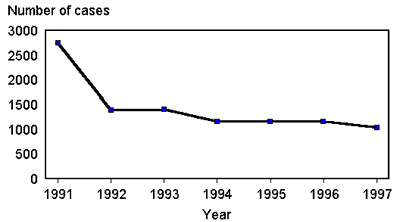 |
* Cases not notifiable nationally prior to 1991
**1997 provisional data |
The burden of suffering caused by Hib disease includes coma, seizures,
paralysis, temporary or permanent brain damage, developmental delays, speech and language
disorders, deafness, inner ear inflammation, sinus infection, brain abscess, conjunctivitis, bronchitis, pneumonia,
epyema, bacterial meningitis, and death. There is no treatment for the Hib virus itself; only the symptoms can be treated,
and very high doses of antibiotics are given for bacterial complications. Thousands of children
were spared these complications when they received the Hib vaccine.
Chart 2. Hib meningitis in
children less than 5 years old according to the National Bacterial Meningitis Reporting System,
1980 through 1991.
In reducing the incidence of Haemophilus influenzae,
the vaccine also dramatically reduced an associated deadly
meningitis. |
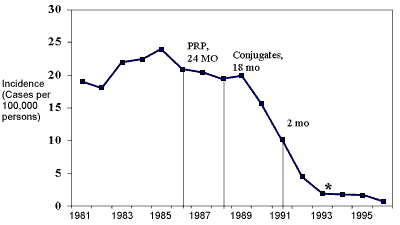 |
* Active laboratory-based surveillance started, increasing sensitivity. |
Chart 3. Reported cases of
measles, United States, 1960-1997*
Measles vaccine reduced measles cases by 99.95%. |
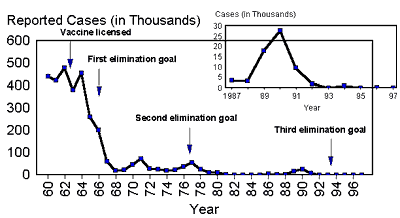 |
*1997 provisional data |
Measles symptoms include high fever, runny nose, cough,
conjunctivitis, and rash. Among the complications of measles are diarrhea, ear infections, croup,
pneumonia, encephalitis, brain damage, and death. In some survivors, SSPE--a condition that
progressively destroys brain cells and is always fatal--strikes years later. Severe cases of
measles can be treated with Ribavarin, an anti-viral drug, but in most cases, treatment must focus
on symptom relief.
Chart 4. Reported mumps cases,
United States, 1968-1997*
Mumps vaccine reduced mumps cases by 99.57%. |
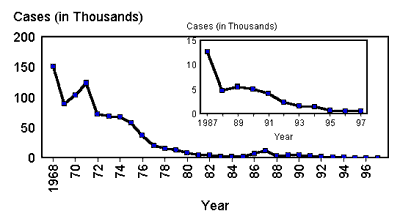 |
*1997 provisional data |
Mumps is a notoriously uncomfortable disease that causes fever,
headache, and swelling of the salivary glands (jaws and cheeks). Among the complications that
mumps may cause are mumps meningitis, mumps encephalitis (especially in adults) with subsequent
seizures, paralysis, or hydrocephalus (fluid on the brain), permanent brain damage, deafness,
painful swelling of the testicles in both boys and men, painful infection of the ovaries in women,
and permanent male sterility. There is no treatment for the virus itself. Mumps meningitis usally
resolves untreated. No treatment is available for mumps encephalitis, permanent brain damage, or
sterility.
Chart 5. Reported pertussis
cases, United States, 1922-1997*
Pertussis vaccine reduced pertussis cases by 97.56%. |
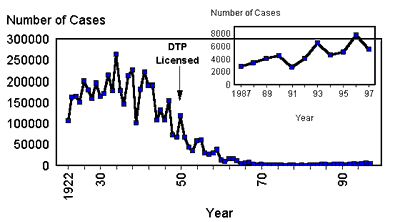 |
|
*1997 provisional data |
Pertussis begins with a runny nose, frequent severe coughing episodes
that may cause vomiting and an associated weight loss due to inability to eat. Complications
include nosebleeds, small hemorrhages in the white of the eye, face swelling, ear infections,
small areas of lung collapse with subsequent pneumonia, convulsions, coma, brain damage, possible
subsequent learning or behavior problems, and death. Antibiotics may be used to kill the pertussis
bacteria in the nose and throat and possibly to reduce the coughing. Brain damage and learning and
behavior problems may be permanent.
Chart 6. Reported poliomyelitis
cases, United States, 1920-1997*
Polio vaccines reduced paralytic polio cases by
100%. |
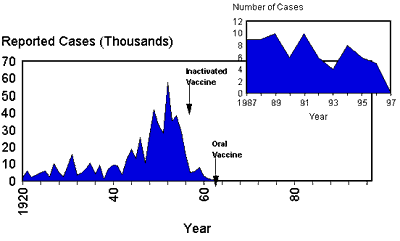 |
* 1975 - 1997 cases are consultant verified. |
Polio appears at first to be a minor illness with fever, sore throat,
muscle aches, drowsiness, headache, loss of appetite, nausea, vomiting, abdominal pain, and
constipation. These symptoms, which may be mistaken for the flu, are followed by viral or aseptic
meningitis with a stiff neck, severe headache, vomiting, and lethargy. In one of every 100
persons, paralytic polio develops, causing sudden onset of weakness or paralysis of various
muscles, severe pain in non-paralyzed muscles, or permanent paralysis; in some, paralysis of the
diaphragm and chest muscles occurs, making it necessary to use a mechanical ventilator to breathe.
Polio can cause death. In some survivors, years later, progressive weakness and paralysis
(post-polio syndrome) develops.
Chart 7. Reported rubella cases,
United States, 1966-1997*
Rubella vaccine reduced rubella cases by 99.64%
,
and congenital rubella syndrome (CRS) deaths by 99.99%. |
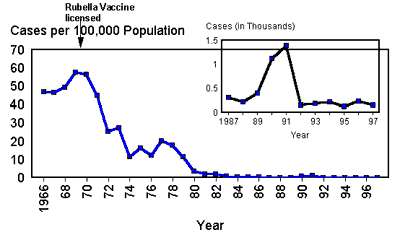 |
*1997 provisional data |
Rubella symptoms include swelling of the lymph glands behind the ear
and at the back of the head, with usually mild illness and low-grade fever, aches and pains,
redness of the eyes, and a rash. Complications that may result include joint pain; a decrease in
the number of platelets in the blood and consequently, small hemorrhages and bruises of the skin;
rubella encephalitis, and SSPE, which progressively destroys nerve cells and is always fatal.
Congenital rubella syndrome (CRS) is the tragic result when a pregnant woman becomes infected with
rubella during the first 20 weeks of pregnancy. CRS causes multiple malformations, organ
abnormalities, and disabilities in the developing fetus, sometimes so severe that death occurs in
early infancy. CRS may cause miscarriage.
Tetanus (lockjaw) symptoms include prolonged, uncontrollable, very
painful muscle spasms, sometimes afflicting all of the muscles at once. Spasms can be so strong as
to cause bone fractures. Difficulty swallowing is common and leads to weight loss. If airway
blockage occurs, it can result in death. The prolonged course of the disease, which may be as long
as 4 weeks, can lead to pneumonia and skin ulcers. Often, lasting impairments in speech, memory,
and mental function occur.
How effective is an individual
immunization?
For most of the millions of people who get immunized every year, a
protective effect occurs; however, in a small percentage of people, this is not the case.
Ineffective immunization results when an individual's immune system does not respond
appropriately. While unlikely to occur in the U.S., vaccines can also be ineffective if not
manufactured properly or not stored and handled properly. The U.S. government has very strict
monitoring policies to guard the safety and effectiveness of vaccines. The Food and Drug
Administration plays a key role in ensuring vaccine safety, which is described in a consumer
article, "How FDA
Works to Ensure Vaccine Safety." In accordance with requirements of the FDA, vaccine
manufacturers also have quality control procedures.
How would I know that my vaccination
worked?
For some vaccinations, it is possible to show that the desired
protective response is achieved by measuring antibodies to components of the vaccine. However,
except in rare high-risk circumstances (for example, a person bitten by an animal found to be
rabid), this is not necessary and quite impractical, because blood must be collected and
processing of the specimen is expensive. As long as vaccination rates remain high within our
population, those persons in whom a specific vaccination has not produced a sufficient immune
response will still benefit from community
immunity and will be unlikely to develop that specific illness.
How long does the effect of a
vaccination last?
Some vaccinations last, but others do not. The protective effect
weakens or wears off over time, or the organism that causes the disease may change (as the
influenza virus often does), so that the inoculation
generally needs to be given annually to protect against it. For some diseases, such as tetanus
(lockjaw), the tendency for effectiveness to weaken over time can be overcome with follow-up
immunizations. For instance, the Advisory Committee on Immunization Practices recommends that
tetanus and diphtheria vaccines be given every 10 years to assure immunity to both tetanus and diphtheria. So,
the process of protecting yourself and your community from disease relies on more than one step.
Why do we need new shots for influenza
every year?
The vaccine designed for last year's influenza is often not effective
against this year's flu.
For such little things, viruses can be very challenging, even to the
smartest scientists. Viruses engage in very
sophisticated exchanges among themselves and undergo constant change. Just as changing one letter
in your name would make it unrecognizable to your computer, tiny changes in the genetic makeup of
influenza virus may make the virus unrecognizable to your immune system, even following
vaccination. Thus, each time a new version of influenza emerges (which is often yearly), we are at
risk of becoming ill from it. So, scientists must develop new influenza vaccines
for every flu season.
How do
scientists know what type of vaccine is needed for any given year?
How do scientists know what type of vaccine is needed for any given
year? Public health officials and vaccine manufacturers from around the world study influenza
viruses continuously. They pay special attention to illnesses that emerge in areas where people
and certain animals live closely, because some influenza viruses live and transform themselves in
these animals until they are ready to cause infection in humans. Based on what is found in
specimens from around the world, researchers make decisions about new vaccine formulations, with a
goal of staying one step ahead of the viruses.
The name that is given to the flu--for example, Hong Kong flu, or
Spanish flu--refers to the location in which the flu originated. The vaccine given in any year
must protect against not one, but hundreds of versions of the flu that are circulating. Despite
the many challenges in this task, they have been remarkably successful during most of the past two
decades. The CDC center that monitors emerging infectious diseases is the National Center for
Infectious Diseases (NCID). To learn more about global surveillance and other work of NCID, click here.
Why do influenza epidemics occur
so often?
The influenza virus is very hardy. It spreads very easily, in
droplets of secretions from the nose and mouth. And since it is always changing, there are always
people who have no resistance to its new strains. So there are some influenza cases occurring
every year.
Like every living thing, the influenza virus has its own rhythms and
cycles. Heavy regional outbursts, or epidemics, generally occur every two to three years and last
one to two months. While most epidemics in the U.S. occur during winter months, in tropical areas,
flu occurs most often during the rainy season.(24) One reason for
these seasonal cycles is that the virus is very sensitive to heat and ultraviolet light
(sunlight).
Scientific record-keeping shows that since 1946, a new form of
influenza type A has broken out about every 11 years, rapidly becoming pandemic within a year. The
intervals between outbreaks are much shorter than in the past, possibly because modern travel
provides so many opportunities for the disease to thrive.(25)
 |
Footnotes |


